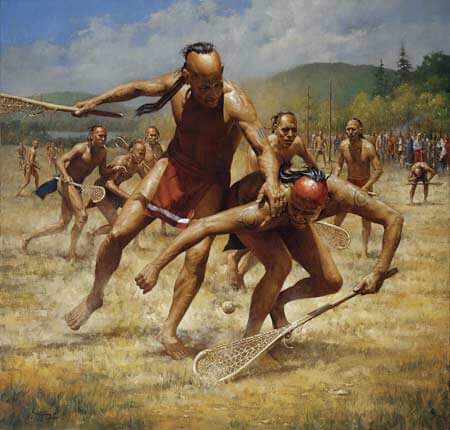LACROSSE 101

OVERVIEW
The first sport in North America, “baggataway” was played by Native Americans as far back as the 1400s, often with thousands of people participating and goals spread miles apart. French colonists referred to the stick used to play as a “crosse” — French for a “bishop’s staff” — and lacrosse was created. A Canadian dentist, W. George Beers, established the rules in 1867 that formed modern lacrosse. Traditionally an East Coast sport, lacrosse has experienced recent growth at the high school and college levels, and the game has rapidly expanded across the country.
The modern game has evolved to become “the fastest game on two feet” due to the rapid pace, high-speed maneuvers, and shots that can exceed 110 miles per hour.
Playing the Game
Men’s field lacrosse involves two teams of 10 players each competing to project a small ball of solid rubber into the opposing team’s goal. The field of play is 110 yards long and 60 yards wide. The goals are 6 feet by 6 feet, containing a mesh netting similar to an ice hockey goal. The goal sits inside a circular “crease”, measuring 18 feet in diameter.
Players line up with 3 offensive players called “attackmen,” players who shoot on the opposing team’s net; 3 “midfielders” or “middies,” who shoot on the opposing team’s net as well as defending their own net; 3 “defensemen,” who guard their own team’s net; and 1 designated goaltender, or “goalie” who stands inside the “crease” and blocks incoming shots. Although most attackmen and midfielders utilize short crosses, defensemen carry long crosses, and one midfielder on defense may carry a long crosse.
Lacrosse Rules
As mentioned, men’s lacrosse is a full-contact sport, with players wearing complete protective equipment. Thus “checking” – striking opponents’ stick or body with the crosse – is legal and very much part of the game.
Each quarter starts with a “face-off” in which the ball is placed on the ground and two “faceoffmen” lay their stick horizontally next to the ball, head of the stick inches from the ball and the butt-end pointing down the midfield line. Faceoffmen scrap for the ball. A face-off also restarts the game after each goal.
In men’s lacrosse, players can be awarded penalties of two types by the referee for rule infractions. Personal and technical fouls always result in the player serving time in the penalty box, located at the side of the field between the opposing teams’ interchange benches. These penalties can last from 30 seconds up to three minutes at the referee’s discretion. Fouls form an important part of men’s lacrosse as while a player is serving time, his team is ‘man down’, offering the opposing team what hockey refers to as a “power-play”.
Basic Terms
Body Check: Hitting an opponent with your body. Players can only hit an opponent within 3 yards of the ball. They can not hit them from the back. Not legal for young players.
Butt or Butt-End: A butt is the end cap at the bottom of the lacrosse stick. Coaches &players refer to the bottom of the stick as the butt-end of the stick.
Clear: A clear is a lacrosse term that means getting the ball out from the defensive half of the field and into the offensive half (i.e. a goalie clear).
Cradling: A technique used to keep the ball in the lacrosse stick when running, etc.
Crease: The circle around the goal that offensive players are not allowed to enter.
Cross Check: An illegal check where a player uses the shaft of his lacrosse stick to check his opponent. According to the rule books, a lacrosse cross-check is a “check with that part of the handle of the crosse that is between the player’s hands, either by thrusting away from the body or by holding it extended from the body”.
D-Middie (or Short Stick Defensive Middie): A D-middie is a short stick middie who specializes in playing defensive. Often replaces a better offensive (but weak defending)middie as the ball transitions to the defensive side of the field.
Dodge: Dodges are where players use various moves to bypass opposing players in order to pass or score.
GLE (Goal Line Extended): An imaginary line that extends out from the sides of the goal. Defenders will try to prevent an attacker from crossing this line (because an attacker
can’t shoot on the goal behind the net).
Ground Ball: A ball that is loose on the ground. As they say, ground balls win games (if you win control of the ground balls).
Hole: A defensive area in front of the goal. You will hear “Get back in the hole!”.
LSM: LSM stands for a Long Stick Middie. This is a defensive middie armed with a long defensive stick.
Man-Down/Man-Up: Due to a penalty (i.e. slashing), a Man-Down Situation is where a team is playing with one less player for a set period of time. The team is down “a man” in
numbers.
Middie Back: If a defender crosses the midfield line with the ball, a midfielder must stay back in order to maintain three “defenders” plus the goalie in the defensive half of the field. You will hear players yelling “Middie Back” to tell a midfielder to stay on the defensive side of the field in order to avoid an off-sides penalty.
Off-Sides: A penalty where the requisite numbers of players are not on their side of the field (i.e. three defenders and the goalie). Someone has gone “off-sides” and there are
now too many players on one half of the field.
Ride: A ride is a lacrosse term for when an offensive player will “ride” an opposing defensive player with aggressive stick checks in order to force a turnover and get the ball. For example, on a clear, a goalie could pass the ball to one of his defensemen and an opposing attackman will ride the defender in order to force a turnover or to prevent a possible
fast break.
Slide: Where a defenseman has left his position or player to help another defender (especially if the other defender has been beaten by an offensive player).
Top-Side: This is where an offensive player tries to get above a defender into the middle of the field for a better percentage shot. A defender will try to prevent an opposing player from getting top side.
Wall Ball: This is a great lacrosse training tool where players use a wall to practice passing, shooting, and catches.
Warding: Warding is an illegal technique where a player does a one-arm cradle and moves his free arm to block an opposing player’s stick (versus keeping it stationary).
X: X is a position about 5-10 yards behind a lacrosse net
